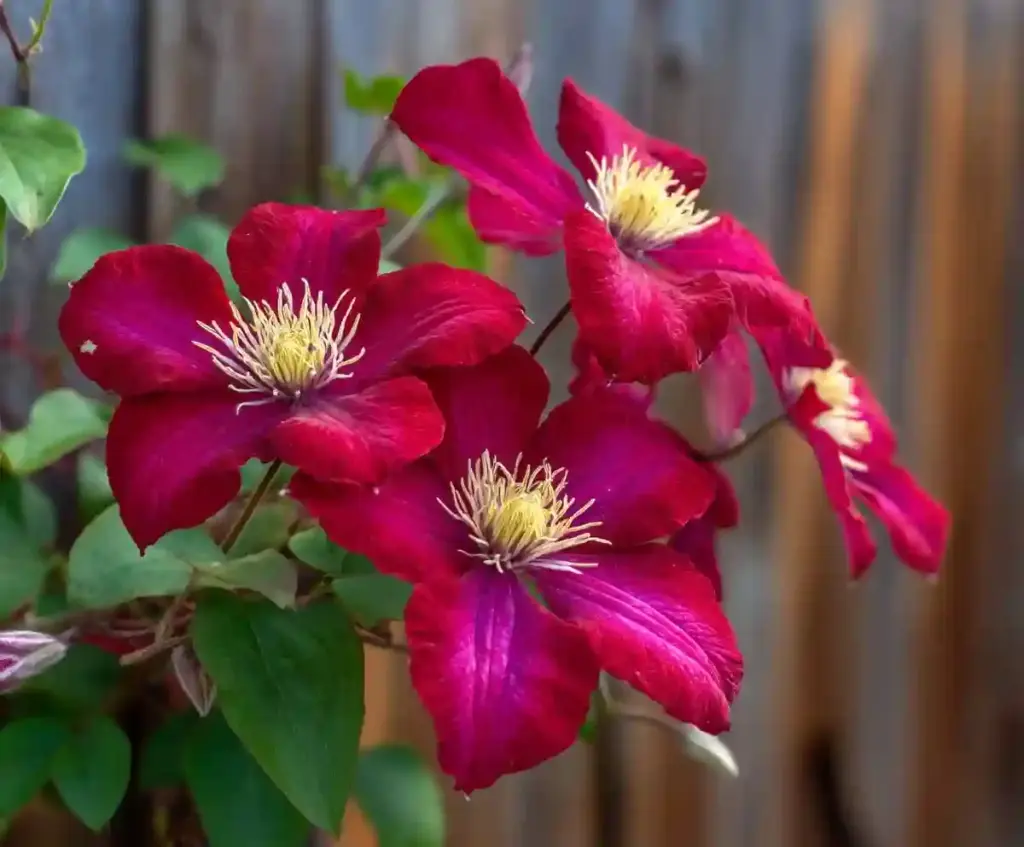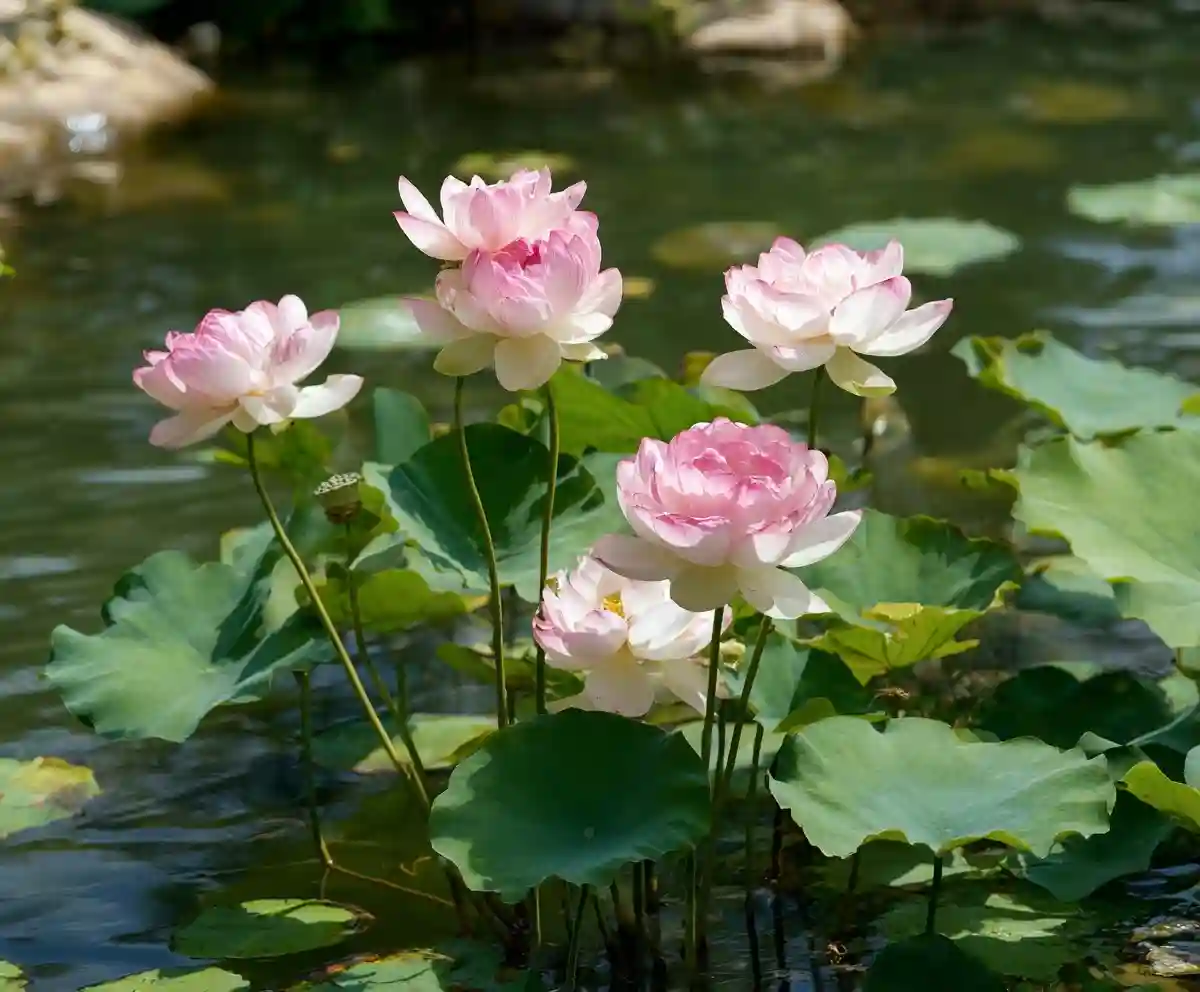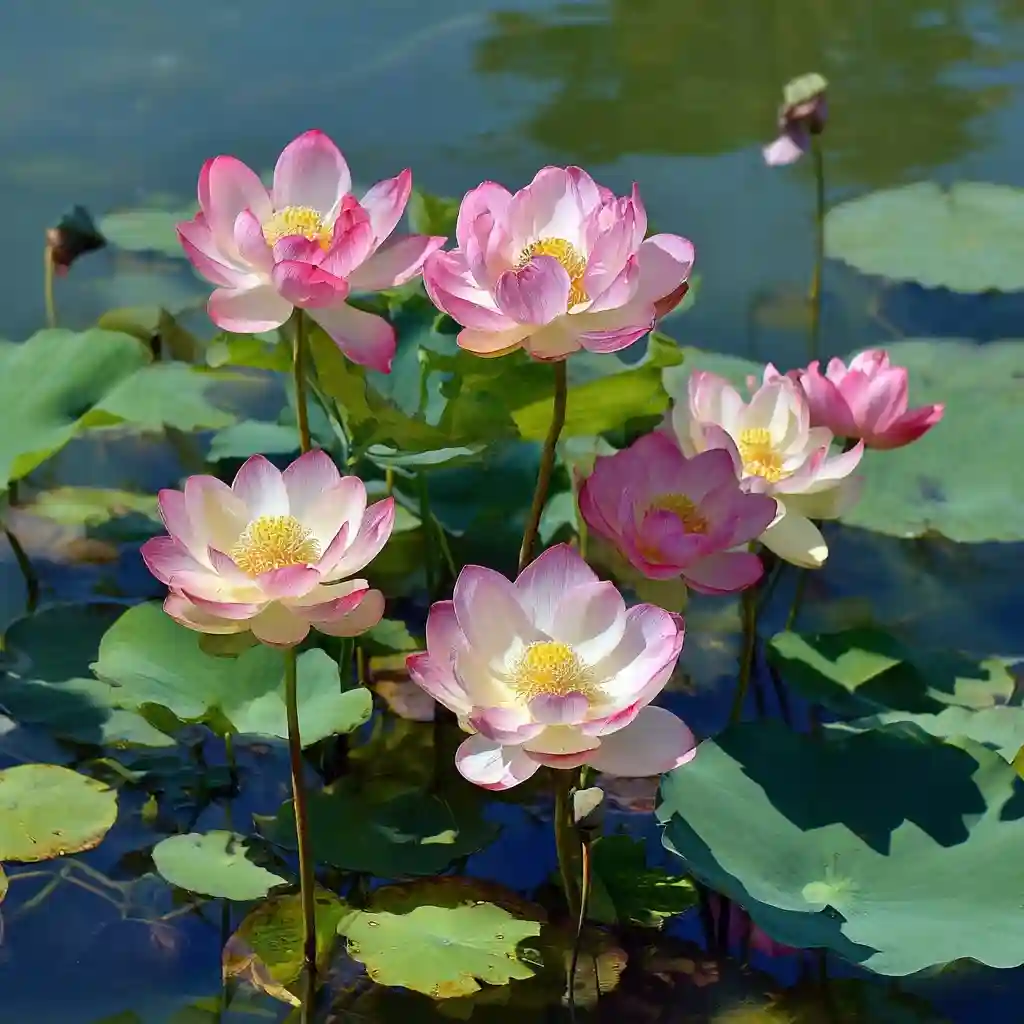Lotus flowers are among the most breathtaking additions you can make to a backyard pond or water garden. Known for their elegant blooms that rise above the water’s surface, these aquatic perennials (Nelumbo spp.) have long been symbols of beauty, purity, and resilience. Unlike water lilies, which float on the surface, lotus flowers grow on tall stems that extend above the water, giving them a unique, statuesque presence.
Often confused with their lily look-alikes, lotus flowers are distinctly different in both structure and behavior. Their broad, waxy leaves stand upright, shedding water effortlessly, while the blooms—ranging in shades from white to pink to yellow—appear in mid to late summer and continue into autumn.
Lotus flowers thrive in warm conditions and are hardy in USDA zones 4a through 10b, as long as their roots remain unfrozen. With the right care, they can spread quickly via rhizomes and bring color and serenity to any aquatic setting.
Table of Contents
Lotus Plant Care
Growing lotus flowers isn’t difficult once you understand their preferences. These plants love sunshine, consistently moist soil, and a little extra attention when grown in containers. Whether you’re cultivating them in a pond or a decorative water bowl, they reward consistent care with lush leaves and impressive blooms.
At a glance, lotus plants require:
- Full sun: At least 6 hours of direct sunlight per day.
- Wet soil: Soil should never dry out—lotus are aquatic by nature.
- Proper fertilization: Especially important for container-grown lotus.
- Careful containment: Some cultivars can become invasive in natural water bodies.
🌿 Invasiveness Warning
Some types of lotus flowers, particularly hybrid cultivars, can spread aggressively if planted directly in ponds or lakes. To avoid ecological disruption, always grow them in containers without drainage holes and consult your local extension office if planting outdoors.
Care Requirements by Category
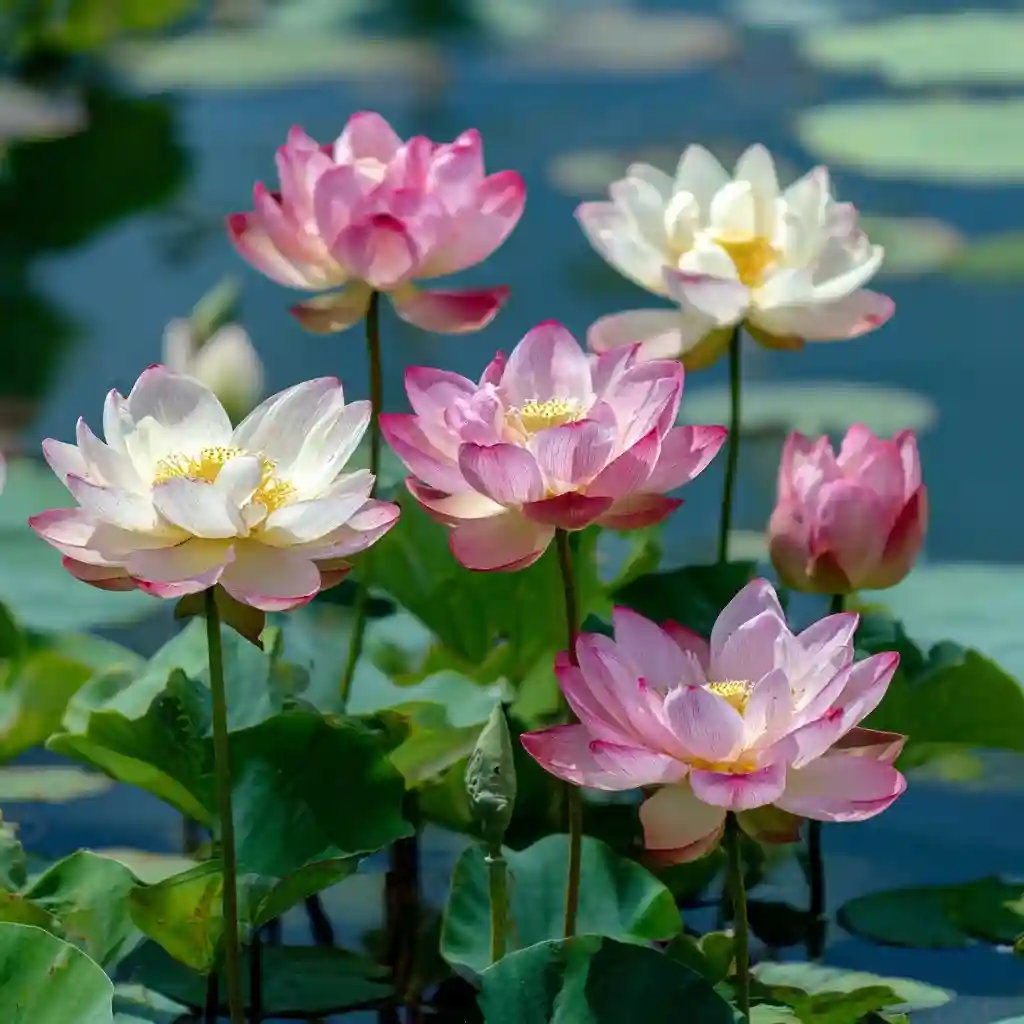
Light
Lotus flowers demand plenty of sunlight to thrive. Ideally, they need a minimum of six hours of direct sun each day to produce their signature large leaves and stunning blooms. Without enough sun, the plant may grow foliage but fail to flower.
If you’re growing lotus in a container, place it in the sunniest spot available. In shadier climates, consider relocating the pot mid-season to chase sunlight as the angle changes.
Soil
Rich, dense soil is essential for healthy lotus growth. The best mix is fertile silt loam or clay, which anchors the roots and holds nutrients well. If you’re potting your lotus, use a blend of topsoil and pine bark, or opt for a commercial aquatic planting medium.
Avoid loose or sandy soils—they don’t provide the stability or nutrition lotus flowers need to support vigorous growth.
Water
Because lotus are aquatic plants, moisture is non-negotiable. Keep the soil constantly wet, but be cautious during the early spring—young shoots should not be submerged until they are well established above the soil line.
For container-grown lotus, maintain water just above the soil surface at first. Once the plant matures, you can gradually submerge the container deeper—up to 12 inches below the water line.
💧 Tip: Always avoid placing lotus in water that freezes solid during winter. Ice can damage the rhizomes.
Temperature and Humidity
Lotus flowers are surprisingly cold-hardy, surviving in USDA zones 4a through 10b—as long as their roots don’t freeze. Some cultivars are better suited to cold climates than others, so it’s worth checking hardiness ratings when choosing a variety.
Humidity isn’t typically an issue since the plant naturally thrives in aquatic environments.
Fertilizer
In natural ponds, lotus plants pull nutrients from decomposing organic matter. But container-grown lotus need a helping hand. Use a water-soluble fertilizer with a 20-10-20 ratio every 20 days during the growing season.
Apply fertilizer carefully—avoid direct contact with new shoots or the rhizome tip to prevent burning.
Types of Lotus Plants
There are two primary species of lotus flowers, along with dozens of cultivated varieties offering diverse colors, sizes, and forms. Whether you’re growing for ornamental beauty, spiritual symbolism, or edible parts, there’s a lotus to suit every garden pond.
Species
Nelumbo lutea (American Lotus)
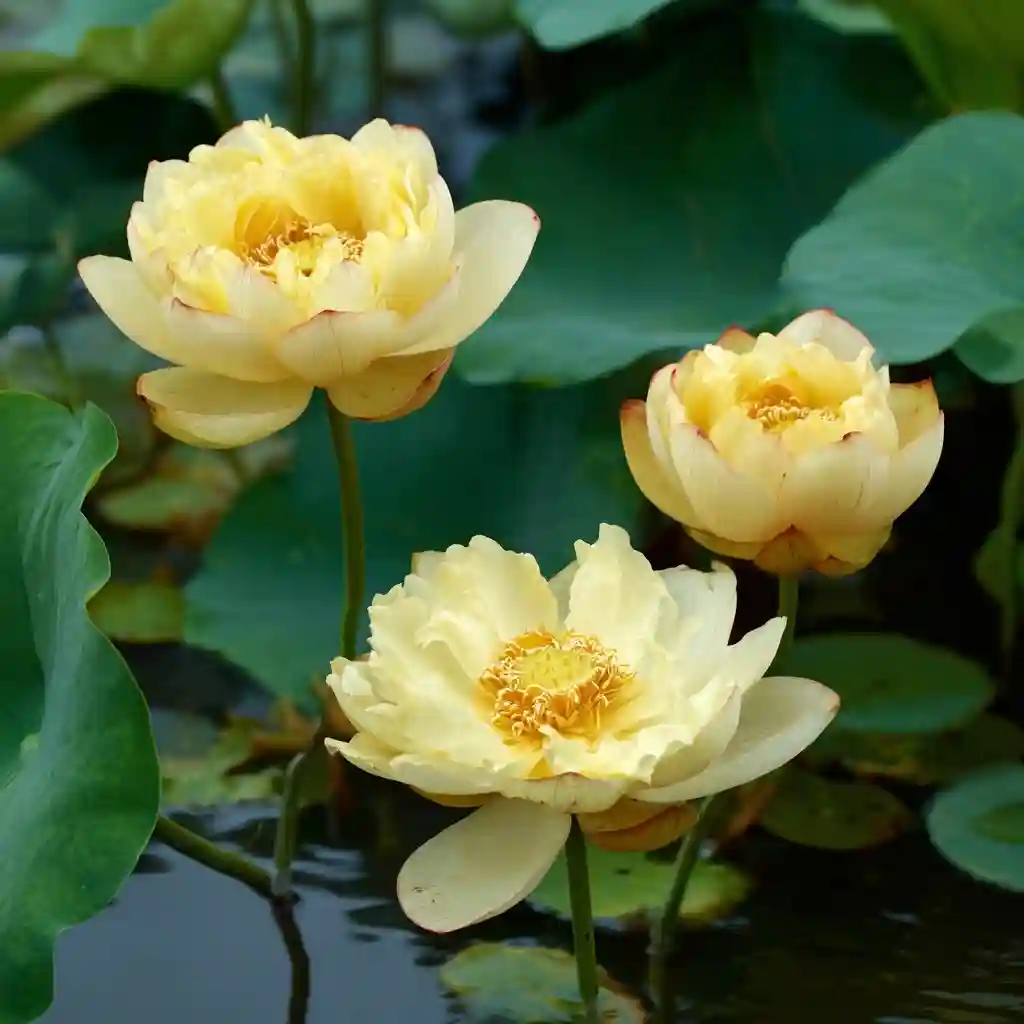
This native North American species features pale yellow or creamy white blooms that can span up to 10 inches across. It naturally occurs in ponds, lakes, and slow-moving rivers across the U.S. and Canada. Its leaves are large and circular, and the plant spreads vigorously in the right conditions.
Nelumbo nucifera (Sacred Lotus or Asian Lotus)
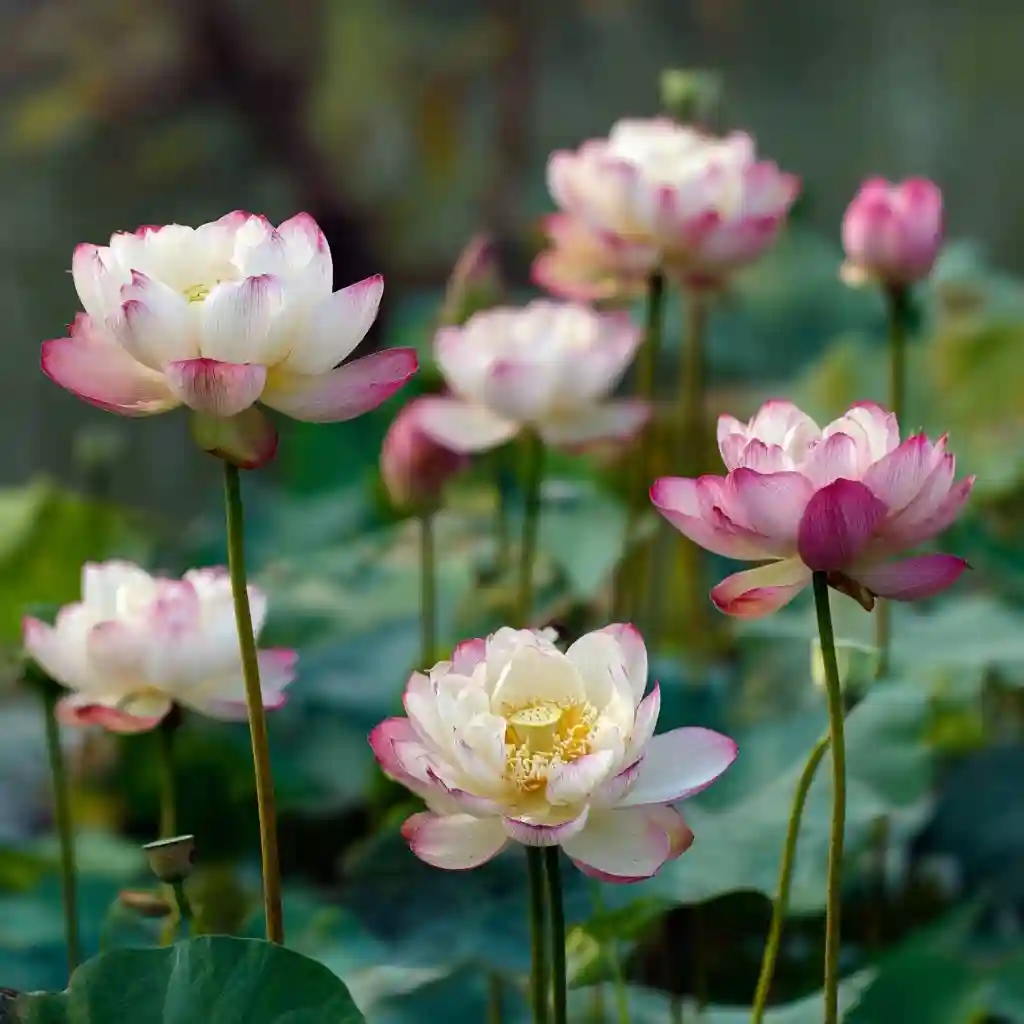
Known for its deep spiritual and cultural significance in Asia, this species bears large white or pink flowers and has edible seeds, roots, and stems. Native to India and East Asia, it’s been cultivated for centuries and is often used in ornamental ponds, especially in warmer regions.
Popular Cultivars
These cultivated lotus flowers have been bred for size, color, or container adaptability:
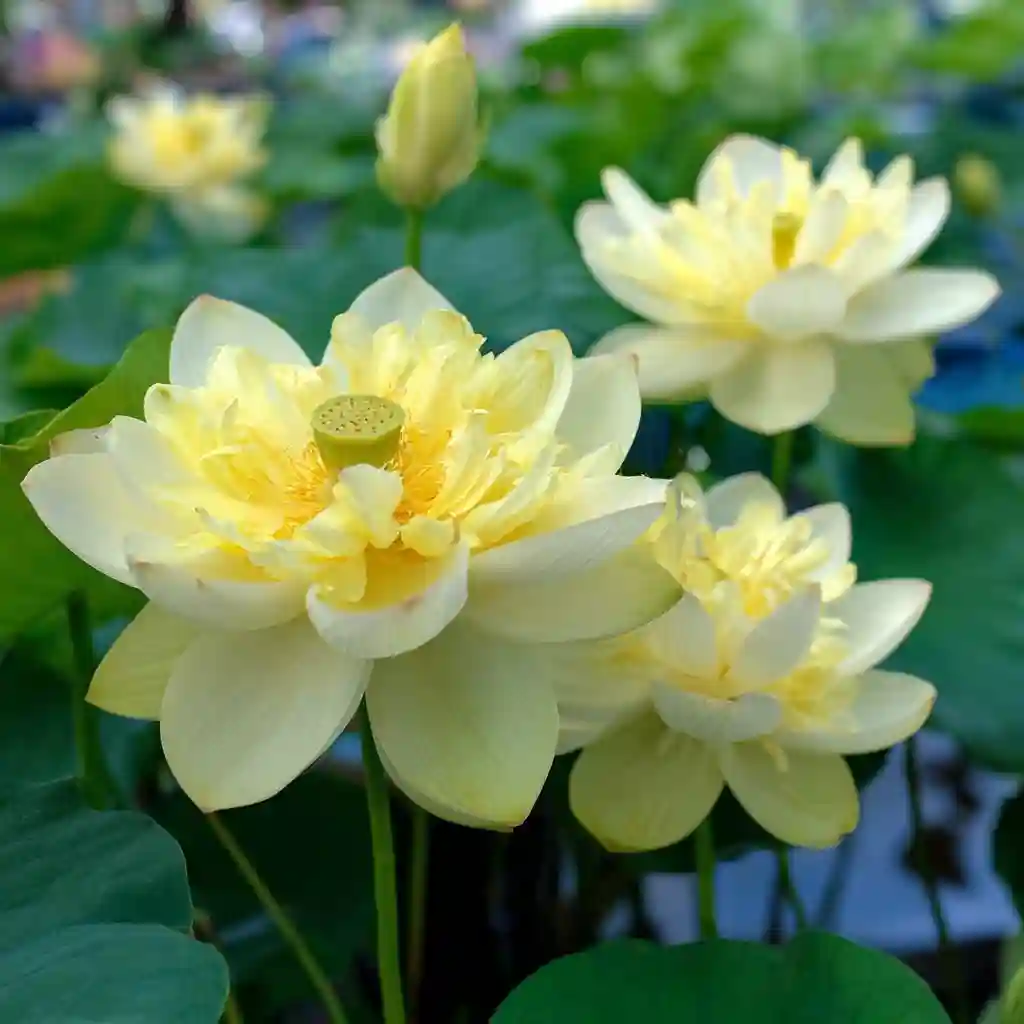

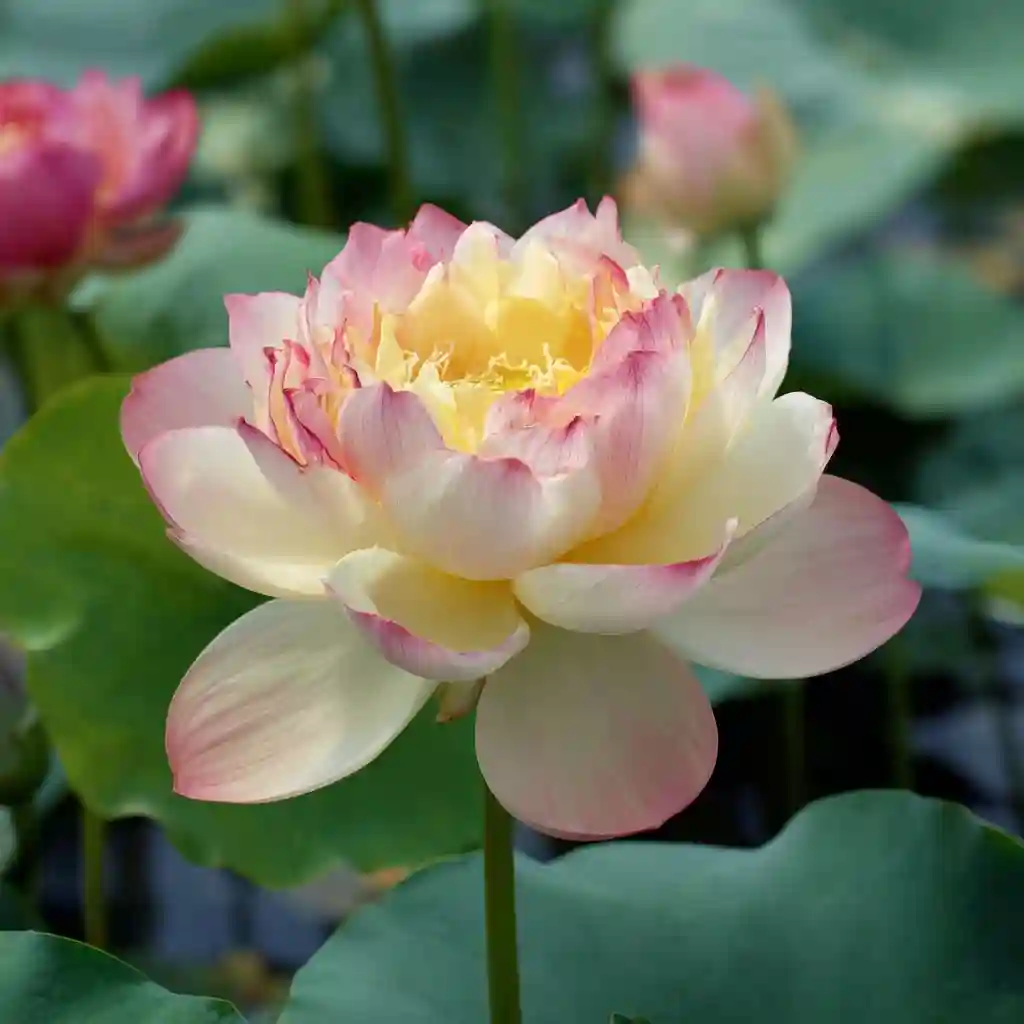
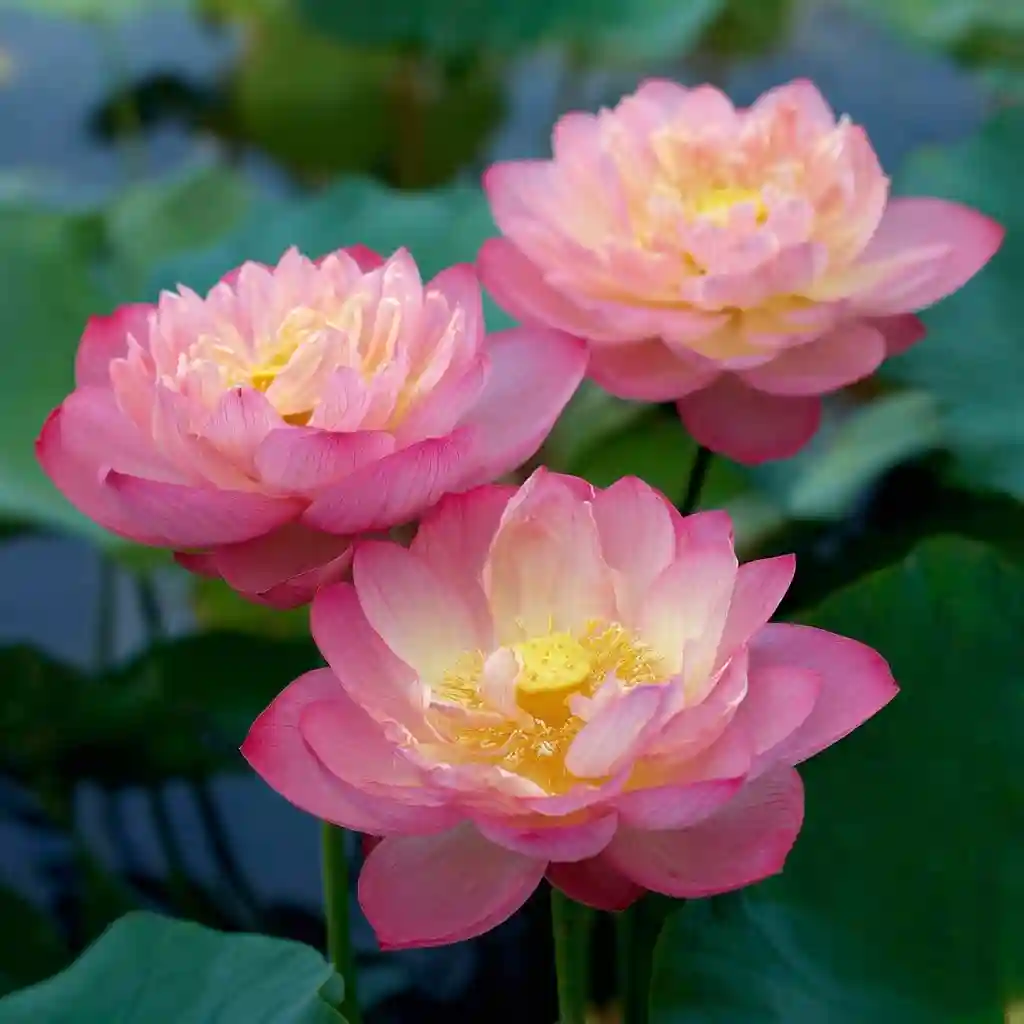

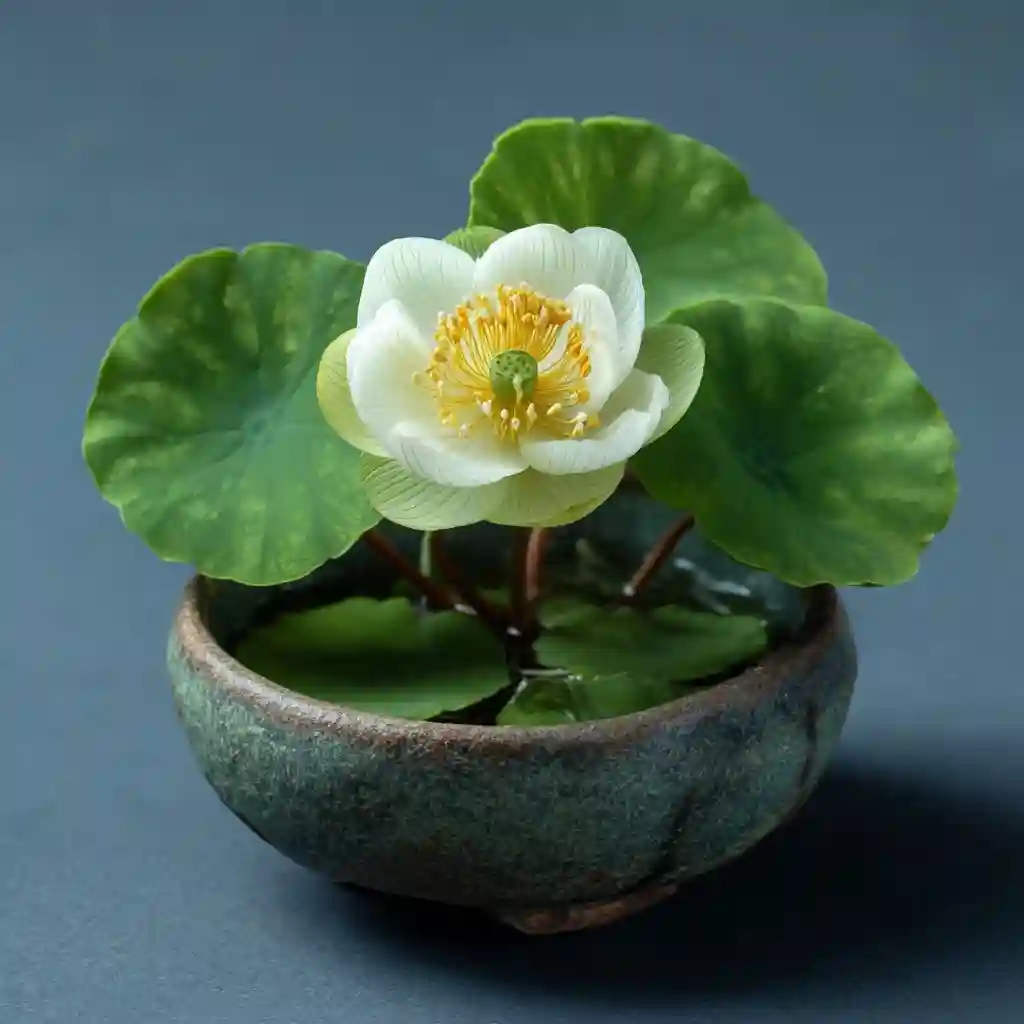

- Chongban Bayi Lian
A miniature double-petaled lotus with blush pink tips and a golden center—ideal for small containers or balcony ponds. - Ancient Capitol Red Palace
Produces striking deep red blooms atop tall, 4-foot stems. A dramatic centerpiece for large water gardens. - Green Jade of Qinhuai
A compact cultivar with double white petals and a green-tinted center. Perfect for tabletops or small decorative pots. - Mrs. Perry D. Slocum
This variety changes color as it matures—from pink to yellow to creamy white—and has a strong fragrance. - Missouri
One of the hardiest lotus cultivars, with bold pink flowers and robust cold tolerance. - Pink Beauty
Delivers classic lotus aesthetics with light pink petals and darker centers. Great for both ponds and tubs. - Sunburst
A fast-growing yellow-flowered lotus known for vigorous blooming and large leaves.
Lotus Maintenance
Pruning
Routine pruning helps your lotus flowers stay productive and visually appealing. During the growing season, remove any yellowing or dead leaves to prevent decay and reduce pest problems. Use clean, sharp scissors to snip stalks just above the waterline.
Major pruning should be saved for late fall or early winter, once the plant has gone dormant. Trim back all foliage and spent blooms to prepare the lotus for overwintering and healthier regrowth in spring.
Propagation
While lotus can grow from seed, the most reliable way to propagate is through rhizome division in early spring. Here’s how:
- Gently remove the lotus from its container.
- Rinse off excess soil to expose the rhizomes.
- Use a sterile knife to divide the rhizomes, ensuring each section has at least one healthy growth node.
- Replant divisions immediately into fresh, wet soil in a pot with no drainage holes.
- Cover the rhizomes halfway with soil, add gravel to anchor them, and slowly refill with water.
Propagation every two to three years helps prevent overcrowding and encourages stronger blooming.
Growing from Rhizomes
If starting from a nursery-bought rhizome:
- Use a 5-gallon or larger container without holes
- Add 2–5 inches of heavy loam soil
- Position the rhizome horizontally with the growing tip facing up
- Cover halfway with soil and top with gravel
- Fill with water until the rhizome is submerged by 2 inches
- Place in full sun and watch for leaf shoots in a few weeks
🪴 Tip: Use a submersible aquatic pot if placing the lotus in a pond—avoid mesh baskets that can damage tubers.
Overwintering
Lotus flowers are cold-tolerant, but frozen roots = dead plants. In cold climates:
- Submerge pots in deeper water that won’t freeze solid
- Use a circulating pump to keep pond water moving
- Or remove containers and store in a cool, dark area where temperatures stay above freezing
- Keep soil consistently moist during storage
Check your stored lotus every few weeks to make sure it hasn’t dried out or rotted.
Common Issues
Even with attentive care, lotus flowers can sometimes struggle. Most problems are avoidable with the right conditions, but here’s what to watch for and how to fix it.
Pests & Diseases
Like many aquatic plants, lotus are vulnerable to common garden pests and fungal issues:
- Spider mites and aphids feed on leaves and can cause wilting or curling. Use a gentle spray of water or insecticidal soap.
- Snails and slugs chew holes in leaves. Remove them by hand or use fish-safe snail traps or baits.
- Fungal leaf spot causes dark, mushy patches and yellowing. Remove affected leaves promptly and apply a water-safe fungicide.
🛡️ Prevention Tip: Keep the water clean and free from dead leaves. Good water circulation reduces disease risk significantly.
Blooming Problems
No flowers? Here are the likely culprits:
- Not enough sunlight – Lotus need at least 6 hours of direct sun to bloom.
- Rootbound containers – Overcrowded rhizomes leave little room for flower production.
- Young plants – Some lotus won’t bloom until their second year.
- Late dormancy – If the plant emerged late in spring, flowering may be delayed.
If your lotus is otherwise healthy but not blooming, plan to divide and repot in early spring.
General Problems
Other common issues include:
- Dry soil – Even brief drying can damage rhizomes.
- Frozen roots – Lotus will not survive if the rhizomes freeze solid.
- Poor soil quality – Loose or sandy mixes don’t hold nutrients or support growth.
- Algae buildup – Excess nutrients and still water encourage algae, which competes with lotus for resources.
Maintain a balance of light, water, and nutrient-rich soil to keep your lotus flowers thriving all season long.
Conclusion
Lotus flowers are more than just beautiful—they’re resilient, symbolic, and surprisingly easy to care for when given the right conditions. From sunny pond edges to patio containers, these aquatic perennials bring color and calm to any outdoor space. With regular maintenance, mindful planting, and proper overwintering, you’ll enjoy their elegant blooms year after year.
Whether you’re starting with a rhizome or dividing a mature plant, growing lotus is a deeply rewarding addition to any garden.
FAQ
Are lotus flowers hard to grow?
Once established, lotus flowers are surprisingly low-maintenance. They just need full sun, consistently wet soil, and protection from freezing. Growing in containers makes care and control easier, especially in cooler climates.
How long do lotus flowers last?
Each bloom lasts about three days, opening in the morning and closing by afternoon. However, healthy plants produce multiple flowers in succession throughout the summer and into early fall.
Are lotus flowers the same as water lilies?
No. While both are aquatic plants, lotus flowers rise above the water on tall stems, while water lilies float on the surface. They also belong to different plant families and differ in root systems, growth habits, and symbolism.
Can I grow lotus flowers from seed?
Yes—but it’s tricky. Seeds require scarification (gently sanding the seed coat) and can take several years to reach maturity. Most gardeners prefer growing lotus flowers from rhizomes because it’s faster and more reliable.
🌿 Love gardening inspiration? Follow me on Pinterest for bold plant ideas, tips, and seasonal color!
More Posts





